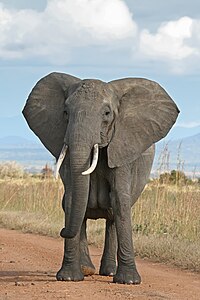
Photo from wikipedia
The sustainability of endangered Asian elephants in human care is threatened in part by low breeding success and concerns over individual animal wellbeing. Male elephants have received less research attention… Click to show full abstract
The sustainability of endangered Asian elephants in human care is threatened in part by low breeding success and concerns over individual animal wellbeing. Male elephants have received less research attention compared to females, yet males deserve special consideration due to their unique reproductive biology (particularly the sexual state of “musth”) and the complex interaction of physiological, environmental, and social pressures they face. We measured fecal androgen metabolites (FAMs), fecal glucocorticoid metabolites (FGMs), and fecal triiodothyronine metabolites (FT3s) collected weekly over approximately 12 months from 26 male Asian elephants housed in zoos across the US, hypothesizing that FAM, FGM, and FT3 concentrations would be associated with temporal correlates of musth and would vary further with intrinsic (musth status, age, body condition) and extrinsic (social environment) factors. The duration of each musth episode was positively associated with exposure to male conspecifics and negatively associated with body condition. Further, elevated FAM concentrations were associated with social exposure, age, and body condition, and FGM concentrations also varied with age and body condition. FT3 concentrations were not associated with any factor we measured. We also identified periods of lower FAM concentration than confirmed musth episodes (but still higher than baseline FAM concentrations) that we termed “elevated FAM episodes.” The durations of these episodes were negatively correlated with exposure to other male elephants. Together, these results provide evidence that hormone profiles (including those that are predicted to change around musth) vary significantly between male Asian elephants in a way that may be attributed to intrinsic and extrinsic factors. Studies like these serve to enhance the sustainability of ex-situ populations by providing wildlife managers with information to enhance the health, welfare, and reproduction of threatened species like Asian elephants.
Journal Title: Conservation Physiology
Year Published: 2023
Link to full text (if available)
Share on Social Media: Sign Up to like & get
recommendations!